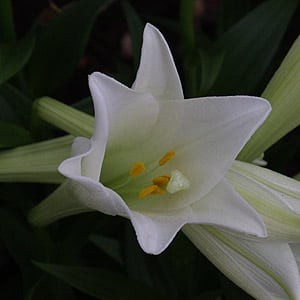Easter lily
(Lilium wallichianum)

Description
Lilium longiflorum, often called the Easter lily, is a plant endemic to both Taiwan and Ryukyu Islands (Japan). Lilium formosanum, a closely related species from Taiwan, has been treated as a variety of Easter lily in the past. It is a stem rooting lily, growing up to 1 m (3 ft 3 in) high. It bears a number of trumpet shaped, white, fragrant, and outward facing flowers. A variety of it, L. longiflorum var. eximium, native to the Ryukyu Islands, is taller and more vigorous. It is extensively cultivated for cut flowers. It has irregular blooming periods in nature, and this is exploited in cultivation, allowing it to be forced for flowering at particular periods, such as Easter. However, it can be induced to flower over a much wider period. This variety is sometimes called the Bermuda lily because it has been much cultivated in Bermuda. From the 1890s to the early 1920s, there was a thriving export trade of bulbs from Bermuda to New York. A disease affected the Bermuda lilies: this was identified by Lawrence Ogilvie. In 1903, USDA Agricultural Research Services (ARS) started to distribute disease free plant materials and seeds. The agency also started a breeding program, and released one of the first dwarf cultivars for potted-plant production in 1929. Prior to USDA's effort, lily bulbs were mostly imported from Japan before the 1940s. The supply of bulbs was suddenly cut off after the attack on Pearl Harbor and Easter lilies became extremely valuable in the United States.
Taxonomic tree:







